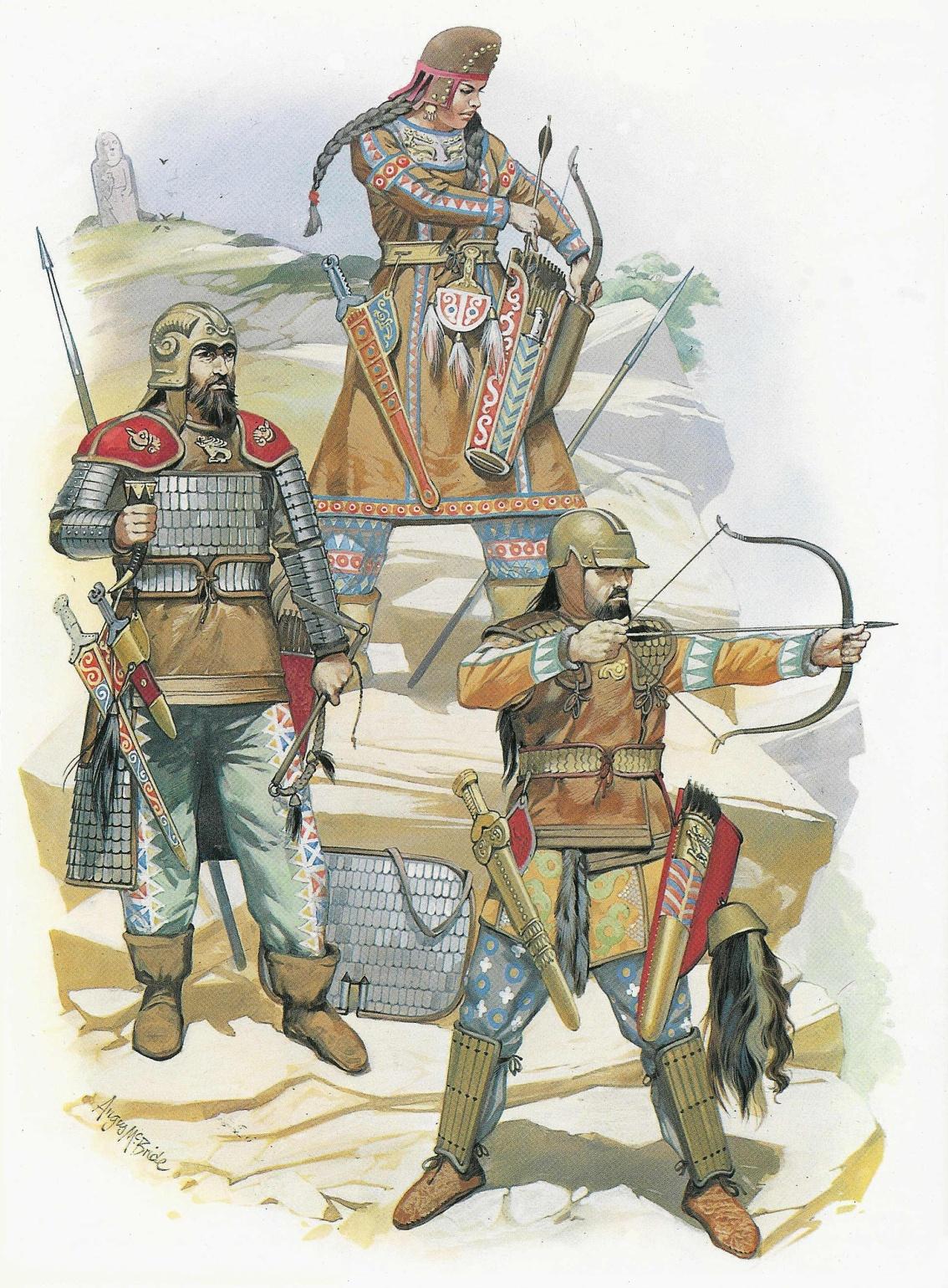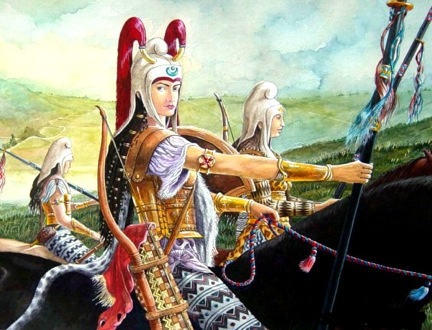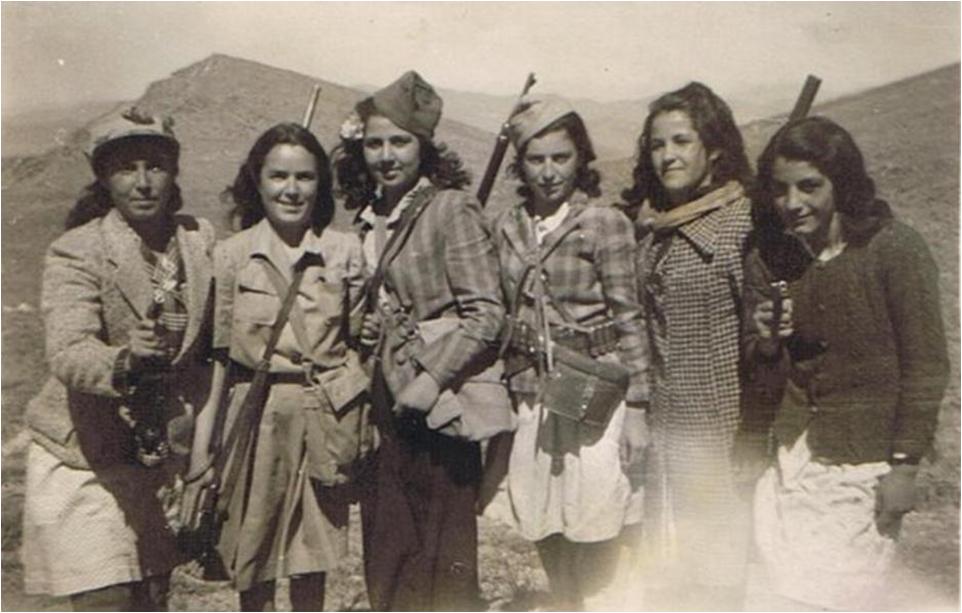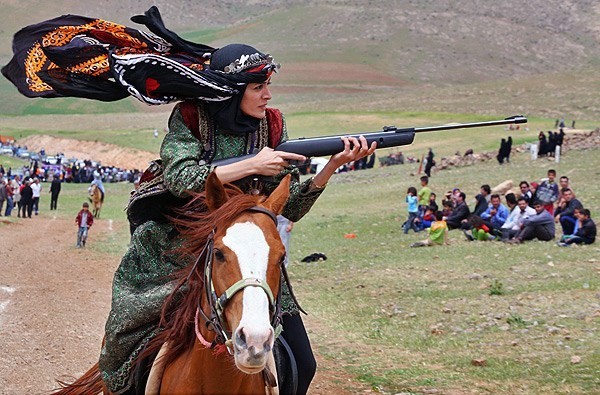The posting below highlights the late Shapour Shahbazi’s discussion of Amazon female warriors which was originally published in the Encyclopedia Iranica on December 15, 1989. Kindly note that none of the images and accompanying captions appear in the original Encyclopedia Iranica article.
Readers further interested in the women of ancient Iran may consult the following resource:
========================================================================
AMAZONS, designation of a fabulous race of female warriors in Greek beliefs, writings, and art, fancifully explained as a-mazos (breastless or full-breasted, see Toepfer, in Pauly-Wissowa I/2, cols. 1765f.). Its derivation from Old Iranian *maz- (combat), producing a folkname *ha-mazan “warrior” (J. Pokorny, Indogermanisches etymologisches Wörterbuch, Bern, I, p. 1959) is also disputed (M. Mayrhofer, “Das angebliche iranische Etyman des Amazonen-Namens,” Studi linguistici in onore di Vittore Pisani, II, Brescia, 1969, pp. 66l-66). The Greeks placed the Amazons on the edge of the world they knew: first, on the Thermodon in northeast Asia Minor and later on the Tanais; and on the Caucasus or even on the Jaxartes as geographical explorations pushed “the East” further (Toepfer, ibid., cols. 1755f.). Thrace (Virgil Aeneid 2.659f.) and Libya (Diodorus 3.53f.) were also claimed as their habitat. Originally, they were associated with Asia Minor, where many cities (Myrine, Cyme and Ephesus) were alleged as their foundations (Diodorus ibid.; Strabo 12.3, 21; Tacitus Annals 3.61.2), and they were made the children of Harmonia—a nymph—and Ares, the clan god to whom they sacrificed white horses. Artemis was another of their chief deities (Toepfer, op. cit., cols 1764f.). Later, however, they were connected with the Scythians as the ancestors of the Sauromatae (Herodotus 4.110-17) or the wives of Asia Minor Scythians whom their neighbors had vanquished (Justin 2.4).
 A reconstruction by Cernenko and Gorelik of the north-Iranian Saka or Scythians in battle (Cernenko & Gorelik, 1989, Plate F). The ancient Iranians (those in ancient Persia and the ones in ancient Eastern Europe) often had women warriors and chieftains, a practice not unlike those of the contemporary ancient Celts in ancient Central and Western Europe. What is also notable is the costume of the Iranian female warrior – this type of dress continues to appear in parts of Luristan in Western Iran (for more on this topic see – Fezana article on Ancient Iranian Women).
A reconstruction by Cernenko and Gorelik of the north-Iranian Saka or Scythians in battle (Cernenko & Gorelik, 1989, Plate F). The ancient Iranians (those in ancient Persia and the ones in ancient Eastern Europe) often had women warriors and chieftains, a practice not unlike those of the contemporary ancient Celts in ancient Central and Western Europe. What is also notable is the costume of the Iranian female warrior – this type of dress continues to appear in parts of Luristan in Western Iran (for more on this topic see – Fezana article on Ancient Iranian Women).
The Massagatae Scythians who defeated and killed Cyrus the Great east of the Caspian Sea were said to be ruled by an Amazon-like queen (Herodotus I, 20 s f.), and it was on the Jaxartes that an Amazon queen came to Alexander’s camp with 300 female warriors to beget children from him and his Macedonian notables (Arrian Anabasis 4.15, 4, 7.13, 4; Curtius 6.5, 24f.; Plutarch Alexander 46). Dionysus also conquered them on his Eastern campaign, a modification, it is claimed, of Alexander stories (W. R. Halliday, The Greek Questions of Plutarch, Oxford, 1928, p. 210f.).
 A reconstruction of a female Achaemenid cavalry unit by Shapur Suren-Pahlav.
A reconstruction of a female Achaemenid cavalry unit by Shapur Suren-Pahlav.
The Amazon’s particular importance is due to their popularity in art from the 7th Century B.C. onward. They are represented in vase paintings and sculptured reliefs in various mythical episodes, against Achilles, Heracles, Theseus and Bellerphone, particularly after the Persian invasion of Greece. For in the mythical invasions of Attica by the Amazons and the defuse of Theseus, implications of the Persian expedition and its fate were perfectly evident. This was highlighted by the oriental background or connections of the Amazons, evidenced especially in their costume—short tunic, Iranian trousers, often variegated and elaborately patterned, and pointed hat with cheek flaps and long neck-guard—and their equipment; the bow, the javelin and the light, crescent-shaped shield, also recalled Oriental arms, as can be seen from such Graeco-Persian monuments as the Heroon of Gjölbaschi, the Nereid Monuments, and the Alexander Sarcophagus (A. Klügmann, Die Amazonen in der attischen Literature und Kunst, Stuttgart, 1875; Pauly-Wissowa, I/2, cols. 1761-89; E. Bielefeld, Amazonomachia: Beiträge zur Geschichte der Motivwanderung in der antiken Kunst, Halle, 1951; D. Bothmer, Amazons in Greek Art, Oxford, 1957; A. Sh. Shahbazi, The Irano-Lycian Monuments, Tehran, 1975, p. 82).
 Iranian women from Malayer (near Hamedan in the northwest) engaged in target practice in the Eznab area of Malayer city limits in the late 1950s. The association between weapons and women is nothing new in Iran; Roman references for example note of Iranian women armed as regular troops in the armies of the Sassanians (224-651 CE).
Iranian women from Malayer (near Hamedan in the northwest) engaged in target practice in the Eznab area of Malayer city limits in the late 1950s. The association between weapons and women is nothing new in Iran; Roman references for example note of Iranian women armed as regular troops in the armies of the Sassanians (224-651 CE).
The Amazons have also found their way into Persian literature and romances through the Alexander-romance of the Pseudo-Callisthenes (The History of Alexander the Great: being the Syriac Version of the Pseudo-Callisthenes, ed. and tr. E. A. W. Budge, Cambridge, 1889, pp. 127f.).

Lur woman in a local competition in Luristan province in Western Iran, partaking in a shooting contest on horseback (Source: Wisgoon.com).




